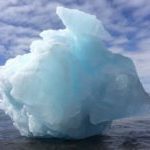
Global warming has “opened the freezer door” to a vast region of East Antarctica where a long-term thaw of ice could raise sea levels by 3 to 4 metres, scientists said on Wednesday.
Researchers used to think that East Antarctica’s ice sheet, which contains about 85 percent of the ice on the frozen continent, was too cold to be affected by climate change, unlike far smaller ice sheets in West Antarctica and Greenland.
The study of the Wilkes Basin in East Antarctica showed the ice is at greater risk than thought from rising world temperatures because it thawed in a warm period between Ice Ages 400,000 years ago, according to the study in the journal Nature.
“We’ve opened the freezer door, but that block of ice is still cold and it’s not going anywhere in the short term,” said first author Terrence Blackburn, assistant professor of Earth and planetary sciences at UC Santa Cruz.
The scientists found that, 400,000 years ago, “the grounding line in the Wilkes Basin retreated 700 kilometers inland during one of the last really warm interglacials, when global temperatures were 1 to 2 degrees Celsius warmer than now,” he said.
“That probably contributed 3 to 4 meters to global sea level rise, with Greenland and West Antarctica together contributing another 10 meters,” he added.said in a statement.
That evidence suggested the melt could happen again, they said, if temperatures keep rising, and similarly contribute to sea level rise. Temperatures have risen about 1C since pre-industrial times and are on track to rise by more than 3C by 2100 on current trends.
The area studied is only part of Antarctica, which locks up enough ice to raise sea levels by almost 60 metres if it all melted. Greenland contains ice equivalent to about six metres of sea level rise.
The scientists studied traces of uranium-234, which gradually accumulates in ice, and is flushed out to background levels during warm periods in the Earth’s history, to date their findings.
The UN’s Intergovernmental Panel on Climate Change (IPCC), said last year that global sea levels could rise by about a metre in the worst likely case by 2100 if greenhouse gas emissions keep climbing. Ocean levels rose 16 cms in the 20th century.
The IPCC said immediate action was needed to limit emissions – effectively ‘closing the freezer door’ to a further melt. In the 2015 Paris Agreement, almost 200 nations agreed to limit warming to well below 2C.
The new study amplifies the alarm bells about East Antarctica sounded by the IPCC.
The IPCC report pointed to worrying signs in East Antarctica that could herald an unstoppable, runaway melt.
“Acceleration of ice flow and retreat in Antarctica, which has the potential to lead to sea level rise of several metres within a few centuries, is observed in the Amundsen Sea Embayment of West Antarctica and in Wilkes Land, East Antarctica,” it said.
“These changes may be the onset of an irreversible ice
sheet instability,” it added.
Photo: UC Santa Cruz researchers including graduate student Graham Edwards and Professor Slawek Tulaczyk, seen here in front of Taylor Glacier in Antarctica, investigated ice loss from the East Antarctic ice sheet during past interglacial warm periods. (Credit: Terry Blackburn)
